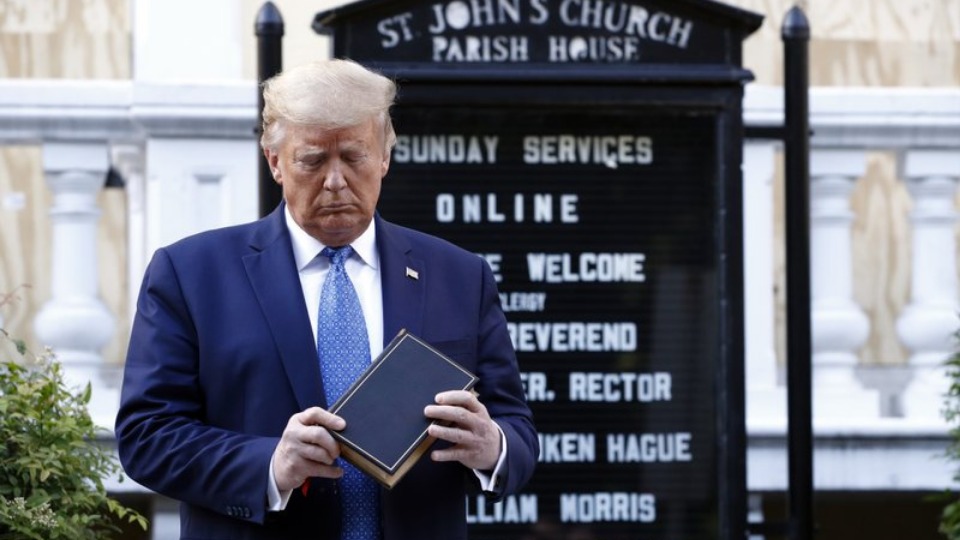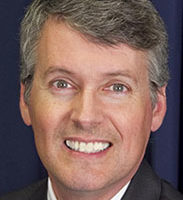
Prodded by Christian nationalist groups, President Donald Trump spent four years eroding the separation of church and state. With Trump leaving office this month, Americans United for Separation of Church and State (AU) provides a look back at 10 especially egregious Trump assaults on religious freedom and separation of religion and government. They are listed in no particular order but be assured that all caused significant damage to religious freedom. It’s up to us to start fixing that.
1.) Trump tries to ‘totally destroy’ the Johnson Amendment
The Johnson Amendment is a 1954 federal law (named for then-Senator Lyndon B. Johnson) that bars tax-exempt nonprofit organizations, including houses of worship, from intervening in partisan politics by endorsing or opposing candidates. While the vast majority of religious leaders happily follow this law, a small minority that wants to politicize their pulpits has been ignoring the Johnson Amendment.
During the 2016 campaign, Trump, obviously prodded by far-right evangelicals, promised to do away with the law if elected. During one rally in Texas, Trump said, “Now we’re gonna get rid of that.… That’s one of the first things I want to do. I want to get rid of that, and politically if we use that power, we’re gonna start going go up up up….”
In May 2017, Trump issued a so-called “religious freedom” executive order he claimed “totally destroyed” the Johnson Amendment. But the amendment is a federal law and can’t be obliterated by a president’s order. In fact, Trump’s order was a lot of verbiage but did not change the law. However, it did spawn confusion and undoubtedly made the IRS reluctant to enforce the law.
2.) Trump warps the definition of ‘religious freedom’
The “religious freedom” executive order Trump issued in May 2017 didn’t just undermine enforcement of the Johnson Amendment. It had two other provisions that were equally troubling.
One section targeted access to birth control. The order erected various roadblocks designed to interfere with the Affordable Care Act’s guaranteed protections that ensure most employer insurance plans cover contraception with no co-pay.
Shortly after Trump issued the order, Tom Price, then secretary of the Department of Health and Human Services, issued a statement vowing to “re-examine” these protections—a euphemism for “revoke.”
Maggie Garrett, AU’s vice president for public policy, noted at the time, “Denying women access to contraception in the name of religion is discrimination, plain and simple.” Under Trump, the federal government worked to curb access to birth control, arguing that a boss somehow had a right under religious freedom to meddle in the personal medical decisions made by his or her employees.
The second portion of the order called on then-Attorney General Jeff Sessions to “issue guidance” for all federal agencies on the scope of religious freedom protections in federal law. The goal was clear: sanction the use of religion as an excuse to roll back equality for LGBTQ people and women. As AU Policy Advocate Samantha Sokol noted recently on AU’s “Wall of Separation” blog, “For the next four years, Trump administration agencies relied on this guidance in justifying harmful policy after policy—denying people access to health care, expanding taxpayer-funded discrimination and attacking LGBTQ civil rights—all under the guise of religious freedom.”
3.) Trump undermines LGBTQ rights
LGBTQ rights in general, and the rights of transgender people in particular, took a number of hits during Trump’s tenure. In July 2017, the president tweeted an announcement that transgender troops would be barred from serving in the military. He took that step without consulting military officials, most of whom opposed the move. Christian nationalist groups, however, were pleased.
The ban was challenged in court, but the Supreme Court allowed it to stand. LGBTQ rights organizations are pressuring President-elect Joe Biden to overturn it.
The ban on trans troops was far from the only assault on trans rights during the Trump years. Shortly after Trump took office, his administration revoked guidance from the era of President Barack Obama reminding public schools that a provision in a 1972 federal law known as Title IX prohibits discrimination against transgender students, including denying them access to restrooms consistent with their gender identity.
Last summer, Trump’s Department of Housing and Urban Development proposed a new rule that would allow single-sex homeless shelters to refuse housing to transgender people, a rule that HUD said would better accommodate the “religious beliefs of shelter providers.” And several health care policies proposed by the Trump administration were aimed at allowing medical providers to refuse to treat transgender people, often on the basis of religious beliefs.
4.) Trump and Education Secretary Betsy DeVos push voucher schemes
Advocates of church-state separation and public education knew there would be trouble when Trump appointed Betsy DeVos to the top education slot. DeVos, a billionaire Michigan resident, had no track record of supporting public education. In fact, she ran organizations designed to siphon taxpayer funds into the coffers of private religious schools through vouchers.
Sure enough, DeVos spent four years more or less ignoring the needs of public schools and looking for ways to promote vouchers. A full-on national voucher bill was never likely to pass Congress, so Trump and DeVos looked for other ways to funnel taxpayer money to private schools. A prominent example was the aid package that passed in response to the coronavirus pandemic. Under the Paycheck Protection Program (PPP), an effort designed to help workers in small businesses at risk of losing their jobs due to the pandemic, billions in public funds were channeled into the coffers of private schools, the majority of them religious.
An Americans United report found that in many cases, private schools were granted more aid per student than public institutions and that tax money was given to private schools that openly discriminate.
5.) Trump subjects health care to religious control
During a May 2, 2019, National Day of Prayer ceremony, Trump unveiled new rules that invited any health care worker—including doctors, nurses, paramedics, administrators, and even clerical staff—to deny medical treatment and services to patients because of personal religious or moral beliefs, even in life-or-death situations.
The vaguely worded “Denial of Care” rule was especially dangerous because it set no limits on what constitutes a religious or moral refusal, nor did it establish appropriate safeguards to ensure that patients denied care get the treatment they need. This could discourage medical facilities from setting and enforcing their own nondiscrimination and emergency policies out of fear that they’d lose federal funding, while also tacitly urging them instead to let their employees arbitrarily deny care to patients on personal religious or moral grounds.
“It is clear that women, LGBTQ people, and religious minorities are the intended targets, but it doesn’t stop there,” AU President and CEO Rachel Laser said. “The rule is so broad that everyone—including sick children, pregnant women, and senior citizens—is at risk.”
Americans United and its allies quickly challenged the rule in court in two lawsuits. On Nov. 19, 2019, a federal court in California blocked the rule from going into effect. Observed U.S. District Judge William Alsup, “When a rule is so saturated with error, as here, there is no point in trying to sever the problematic provisions. The whole rule must go.” (Two other courts also struck down the rule, though the Trump administration launched an appeal that is still pending.)
6.) Trump imposes a Muslim ban
Trump’s 2016 campaign was heavily anchored in xenophobic attacks on Mexican and Central American immigrants, Muslims, and others, so it’s not surprising that one of his first acts once in office was to impose strict rules designed to restrict people from largely Muslim nations from traveling to America.
The Muslim ban caused undue hardship. Families were separated, and individuals with important skills and talents were barred from coming to America to study or work simply because of their faith. Americans United was among the groups that challenged the ban in court, but the Supreme Court’s conservative majority upheld the ban 5-4 in 2018. Biden has promised to reverse the ban early in his administration.
7.) Trump supports direct taxpayer funding of houses of worship
Since the founding of our nation, federal policy has been that houses of worship and religious entities cannot receive direct taxpayer support for religious activities. Trump began altering this formula in January 2018 when the Federal Emergency Management Agency (FEMA) announced it would change longstanding policy to allow the government to use taxpayer money to rebuild houses of worship damaged in natural disasters.
Before this change, FEMA had offered grants to a limited set of nonprofit organizations to rebuild their structures. Only organizations open to the public and engaged in emergency, essential, and government-like activities qualified. Houses of worship, like most nonprofits—including all those used primarily for “political, athletic, recreational, vocational, or academic training, conferences, or similar activities”—were not eligible for direct funding, although they could receive federal loans to rebuild.
The Trump administration managed to divert even more public money to houses of worship in the coronavirus relief bill’s PPP funding. In addition to funding private religious schools, the Trump administration allowed houses of worship to take part. For the first time in U.S. history, federal funds were used to pay the salaries of ministers and other employees engaged in religious activities.
8.) Trump supports religion-based discrimination
In a variety of ways, the Trump administration sought to codify the alleged “right” of taxpayer-funded social service providers to use religion as a tool to discriminate.
Under Trump, the U.S. Department of Health and Human Services gave tax-funded foster care agencies waivers from rules to prevent discrimination against prospective parents. Trump also promulgated rules that would allow government-funded faith-based organizations that deliver social services—such as food banks, homeless shelters, and elder care centers—to remove religious freedom protections for those in need.
In the closing days of the administration, Trump’s Labor Department issued an appalling rule that allows all federal contractors to discriminate against employees on the basis of religion.
9.) Trump panders to Christian nationalists
Previous presidents have tried to dialogue with a variety of faith and secular communities. Trump focused almost exclusively on far-right evangelicals. He formed an Evangelical Advisory Board and frequently stoked “culture war” issues.
Trump falsely claimed that people were afraid to say “Merry Christmas” and took credit for its alleged resurgence. During a weird rant to a gathering of Boy Scouts in late July 2017, Trump boasted, “And by the way, under the Trump administration, you’ll be saying ‘Merry Christmas’ again when you go shopping. Believe me. Merry Christmas. They’ve been downplaying that little, beautiful phrase. You’re going to be saying ‘Merry Christmas’ again, folks.”
Trump showed little respect for other faiths. On June 1, 2020, he ordered that peaceful protestors near the White House be forcibly removed with chemical agents so he could walk to a nearby church, which he had not been invited to visit, and pose with a Bible for a photo-op.
10.) Trump stacks the federal courts with problematic judges
During Obama’s last two years in the White House, Republicans held the majority in the Senate and dragged their feet on approving Obama’s judicial nominees. As a result, when Trump took office, there were many vacancies to fill. Suddenly the wheels started turning in the Senate, and nominees began flying through the Judiciary Committee.
As this article was being written, Trump had appointed 220 federal judges. (There are 870 federal judges in total.) Among his appointees are three members of the Supreme Court—Neil Gorsuch, Brett Kavanaugh, and Amy Coney Barrett. All three are hostile to church-state separation.
Trump’s stamp on the federal judiciary will extend long beyond his presidency and may prove to be the most damaging feature of his legacy.
* * *
Trump’s attacks on church-state separation infuriated many supporters of religious freedom. These attacks will finally end on January 20, and we can begin the hard work of turning back his dangerous agenda as we look forward to a new day.
A good place to start is the 10-point “Agenda to Restore & Protect Religious Freedom” drafted by Americans United’s Public Policy Department. It stands in stark contrast to Trump’s assaults. Read more about it at www.au.org/BidenAgenda.
Reposted by permission of the author and Church & State Magazine, January 2021, with slight PW format changes. The original publication can be accessed here.










